For more information:
Note that the latest stuff may not yet be indexed.
The Klezmer Shack directory of articles
Here are the capsule reviews from May on the Klezmershack main page. These are all essential recordings--you'll want them all.
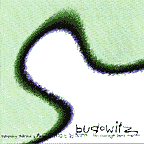 30 May 00: I am also the lucky camper working at home today to witness the arrival
of Budowitz' new "Wedding without a Bride" (Buda Musique, 92759-2, in Europe; currently available in the US by mail order only, from Hatikva Music and to put it on the CD changer immediately,
to me absolute pleasure. It's nearing the end, and I was getting that
comfortable, "ahhh, the pleasures of amazing tsimbl" feeling around
track 19 and had to interrupt work and write this quick note. This is "classical" klezmer in that it is klezmer as it is thought to have been played 100 years ago, but it is also very different from Khevrisa or Di Naye Kapelye. The one thing the three bands have in common, besides repertoire, is how high the bar has been set both in terms of musicianship, and in terms of joy and feeling. In this, of course, each of these bands has broken with tradition. Just as 90% of all bar bands are pretty ghastly, so one presumes were (and are, as I seem to observe) 90% of klezmer bands today.
30 May 00: I am also the lucky camper working at home today to witness the arrival
of Budowitz' new "Wedding without a Bride" (Buda Musique, 92759-2, in Europe; currently available in the US by mail order only, from Hatikva Music and to put it on the CD changer immediately,
to me absolute pleasure. It's nearing the end, and I was getting that
comfortable, "ahhh, the pleasures of amazing tsimbl" feeling around
track 19 and had to interrupt work and write this quick note. This is "classical" klezmer in that it is klezmer as it is thought to have been played 100 years ago, but it is also very different from Khevrisa or Di Naye Kapelye. The one thing the three bands have in common, besides repertoire, is how high the bar has been set both in terms of musicianship, and in terms of joy and feeling. In this, of course, each of these bands has broken with tradition. Just as 90% of all bar bands are pretty ghastly, so one presumes were (and are, as I seem to observe) 90% of klezmer bands today.
This isn't a casual recording of "classical klezmer", however. Instead, the band has chosen on this second recording to document, in the course of an hour, the whole eight-day accompaniment to old-fashioned Jewish weddings. In addition to the music, itself, I must call attention to the excellent liner notes that provide context. Despite adherence to the theory that teeny tiny type across a wide CD booklet page is readable (not so true--two columns would have been much, much better), the actual liner notes are wonderful. "What!" you exclaim, "there's more to it than the bulgars and shers?" Well, in a word, "yes." Josh Horowitz outlines the whole simkha. And not only documents it in word and music, but pulls in the voice of Majer Bogdanski, 88, who provided a record of the ceremony as it was performed in his village, and is one of the primary sources for the recording. To have this documented, on paper, as well as in extraordinary music, is such a pleasure. (You can read about the whole process of meeting Majer and figuring out what to do with the music in notes Josh sent the jewish-music mailing list.) Like the incorporation of Ben Bayzler's voice on Brave Old World's stupendous "Klezmer Music" CD, this is special. To have results that sound this good is to turn the idea of "documentary" into an unusual pleasure. I can deal with that!
Despite pieces that feature individual instruments, this Budowitz recording is very much an ensemble piece, with much of the looseness and interplay of a village band reconstructed such that one sees the wedding in one's mind's eye. In this, and in the intensity of the music, the intent and recording are similar to that of Di Naye Kapelye. In short, CDs like this are both good for you (as documentary), and good--more, excellent--to listen to! Enjoy!
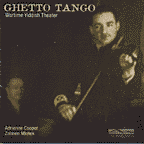 27 May 00: Let us now consider the powerful new recording Ghetto Tango (see website, www.yiddishmusicians.com/ghettointro.htm), out on Traditional Crossroads CD 4297. I first heard this piece, and first recorded it, at Ashkenaz '97, in Toronto. It consists of Adrienne Cooper singing songs that were sung in makeshift cabarets in the ghettos during WWII. She is accompanied by Zalmen Mlotek who, in many ways, is to piano and Yiddish song what Adrienne is to voice: an amazing musician and one who is inseparable from the popularity and popularizing of such song today. So, what you get are these two voices--or one voice, one piano, singing songs, from the (now) well-known "Frihling" to parodies and satire composed in the ghettoes, themselves, even including a bar mitzvah speech from the getto, and an anti-nazi song by Berthold Brecht, "Song of the Nazi soldier's wife." This is important repertoire. It is a part of our memory that we need most--a Jewish response to terrible times that we must never forget. (It is also important to remember that, while Brecht was not in a ghetto or concentration camp, he, like his collaborator, Kurt Weill, was forced to flee the Nazis.) But it is also amazing music performed with a life and excitement and grace that, but for the subject, occasionally cause one to forget the occasion, just as the songs were written and performed in the ghettoes for exactly the same reason. The album opens with a lively, almost joyful "Moyshe Hold On" (Moyshe halt zikh) and never lets go, not for plaintive or sly, nor for powerful. And for that, as I have written before, there is nothing better than the gorgeous voice of Adrienne Cooper, or the full, insidious piano, of Zalmen Mlotek (whose accompanying vocals are rather nice, too). and then, less we forget, there are also the thoughtfully gripping introductions by Ms. Cooper to place the songs in context. Lest we forget. Lest we also forget the human spirit.
27 May 00: Let us now consider the powerful new recording Ghetto Tango (see website, www.yiddishmusicians.com/ghettointro.htm), out on Traditional Crossroads CD 4297. I first heard this piece, and first recorded it, at Ashkenaz '97, in Toronto. It consists of Adrienne Cooper singing songs that were sung in makeshift cabarets in the ghettos during WWII. She is accompanied by Zalmen Mlotek who, in many ways, is to piano and Yiddish song what Adrienne is to voice: an amazing musician and one who is inseparable from the popularity and popularizing of such song today. So, what you get are these two voices--or one voice, one piano, singing songs, from the (now) well-known "Frihling" to parodies and satire composed in the ghettoes, themselves, even including a bar mitzvah speech from the getto, and an anti-nazi song by Berthold Brecht, "Song of the Nazi soldier's wife." This is important repertoire. It is a part of our memory that we need most--a Jewish response to terrible times that we must never forget. (It is also important to remember that, while Brecht was not in a ghetto or concentration camp, he, like his collaborator, Kurt Weill, was forced to flee the Nazis.) But it is also amazing music performed with a life and excitement and grace that, but for the subject, occasionally cause one to forget the occasion, just as the songs were written and performed in the ghettoes for exactly the same reason. The album opens with a lively, almost joyful "Moyshe Hold On" (Moyshe halt zikh) and never lets go, not for plaintive or sly, nor for powerful. And for that, as I have written before, there is nothing better than the gorgeous voice of Adrienne Cooper, or the full, insidious piano, of Zalmen Mlotek (whose accompanying vocals are rather nice, too). and then, less we forget, there are also the thoughtfully gripping introductions by Ms. Cooper to place the songs in context. Lest we forget. Lest we also forget the human spirit.
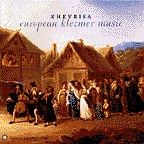 In another direction entirely is the first Khevrisa album ("European Klezmer Music," Smithsonian Folkways SFW CD 40486). Promised on these pages since I first saw them perform at last summer's KlezKanada, this is the latest entry into the very wonderful and edge-pushing field of classical klezmer. By this, I don't mean klezmer performed by amazing classically-trained and influenced musicians (say, the Chicago Klezmer Ensemble), or even the recreation of a toe-tapping, wildly swinging village dance band (Di Naye Kapelye), but, similar (lacking perhaps the wonderful bad attitude and substituting something else) to Budowitz. (I hope that last sentence made sense.) The primary people in Khevrisa are Zev Feldman (cimbal), who played that same instrument on one of the greatest and earliest of klezmer revival albums, "Jewish Klezmer Music," with Andy Statman. (Fans will be pleased to know that after letting that classic lapse out of print for a decade, Shanachie is finally going to remedy that lapse.) In the subsequent 30 years, Feldman has studied and written about Turkish and Jewish music, and this is his first klezmer recording since that time. Co-leading the band is the amazing violin player, Steven Greenman, who studied classical violin, was turned onto klezmer by Josh Horowitz, of Budowitz (with whom he recorded the first Budowitz album, "Mother Tongue"), studied with Alicia Svigals, and has played with klezmer bands around the world. If you stop and register for a moment that Alicia Svigals, whose only "Fidl" album, and teaching at KlezKamp, has played a big role in the revival of interest in klezmer violin is playing backup, as is Michael Alpert (now of "Brave Old World," among many endeavors) and Stu Brotman (also BOW, among many endeavors), one will be somewhat prepared for the beauty of this music. This is classical music. No, it's klezmer. Feldman and Greenman have uncovered manuscripts of an entirely unfamiliar repertoire of "the music that klezmorim played for special occasions, especially to impress rich patrons." We are much the richer for it, and even so, there are also many familiar tunes here, along with the classical. Compare this "fun der khupe" with the preserved sounds of IJ Hochman, or for that matter, with "Fun der kretshme" (see, "di Shikere Kapelye," below). Listen to the cimbal playing of Joseph Moscowitz and then consider what Zev is doing. Even better, listen to recordings Steven Greenman has made over the years and listen to him come into his own here. He is no longer a prodigy, he is a musician who is finding his voice and sounding more like himself with every note. Our privilege is to be present, listening to this recording, listening to it all happen.
In another direction entirely is the first Khevrisa album ("European Klezmer Music," Smithsonian Folkways SFW CD 40486). Promised on these pages since I first saw them perform at last summer's KlezKanada, this is the latest entry into the very wonderful and edge-pushing field of classical klezmer. By this, I don't mean klezmer performed by amazing classically-trained and influenced musicians (say, the Chicago Klezmer Ensemble), or even the recreation of a toe-tapping, wildly swinging village dance band (Di Naye Kapelye), but, similar (lacking perhaps the wonderful bad attitude and substituting something else) to Budowitz. (I hope that last sentence made sense.) The primary people in Khevrisa are Zev Feldman (cimbal), who played that same instrument on one of the greatest and earliest of klezmer revival albums, "Jewish Klezmer Music," with Andy Statman. (Fans will be pleased to know that after letting that classic lapse out of print for a decade, Shanachie is finally going to remedy that lapse.) In the subsequent 30 years, Feldman has studied and written about Turkish and Jewish music, and this is his first klezmer recording since that time. Co-leading the band is the amazing violin player, Steven Greenman, who studied classical violin, was turned onto klezmer by Josh Horowitz, of Budowitz (with whom he recorded the first Budowitz album, "Mother Tongue"), studied with Alicia Svigals, and has played with klezmer bands around the world. If you stop and register for a moment that Alicia Svigals, whose only "Fidl" album, and teaching at KlezKamp, has played a big role in the revival of interest in klezmer violin is playing backup, as is Michael Alpert (now of "Brave Old World," among many endeavors) and Stu Brotman (also BOW, among many endeavors), one will be somewhat prepared for the beauty of this music. This is classical music. No, it's klezmer. Feldman and Greenman have uncovered manuscripts of an entirely unfamiliar repertoire of "the music that klezmorim played for special occasions, especially to impress rich patrons." We are much the richer for it, and even so, there are also many familiar tunes here, along with the classical. Compare this "fun der khupe" with the preserved sounds of IJ Hochman, or for that matter, with "Fun der kretshme" (see, "di Shikere Kapelye," below). Listen to the cimbal playing of Joseph Moscowitz and then consider what Zev is doing. Even better, listen to recordings Steven Greenman has made over the years and listen to him come into his own here. He is no longer a prodigy, he is a musician who is finding his voice and sounding more like himself with every note. Our privilege is to be present, listening to this recording, listening to it all happen.
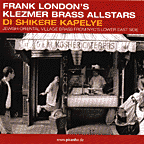 And in yet a third direction, there is Frank London's latest project, "Di Shikere Kapelye." (Piranha CD-PIR 1467) I confess that I was apprehensive first time I put this on my turntable. Given London's range, this could have been anything. Instead, it is something that I have missed for years, and now that it's here, I now realize how much I've missed it, and how grateful I am that it's back. It's village music. It's a klezmer brass band. And if, like me, you spend time enjoying gypsy brass bands, or even the US equivalent in bands such as Zlatne Uste, you'll begin to appreciate how wonderful it is to hear the klezmer equivalent. Yeah, think of this as Zlatne Uste playing klezmer. Or, imagine the soundtrack to a movie such as "Underground" if it were played by klezmorim, rather than by a Serbian brass band. In fact, some numbers, such as "going to the bar" ("Tsu der kretshme") do a wonderfully balkan 11/4 or some such (my ability to count beats is legendarily bad, but I can dance a good serbian dance to this. Of course, here there are many familiar melodies, if all wrapped in new thematic names such as the aforementioned, "from the bar" or the differentiated medley, "a shot of brandy/another shot of brandy."
And in yet a third direction, there is Frank London's latest project, "Di Shikere Kapelye." (Piranha CD-PIR 1467) I confess that I was apprehensive first time I put this on my turntable. Given London's range, this could have been anything. Instead, it is something that I have missed for years, and now that it's here, I now realize how much I've missed it, and how grateful I am that it's back. It's village music. It's a klezmer brass band. And if, like me, you spend time enjoying gypsy brass bands, or even the US equivalent in bands such as Zlatne Uste, you'll begin to appreciate how wonderful it is to hear the klezmer equivalent. Yeah, think of this as Zlatne Uste playing klezmer. Or, imagine the soundtrack to a movie such as "Underground" if it were played by klezmorim, rather than by a Serbian brass band. In fact, some numbers, such as "going to the bar" ("Tsu der kretshme") do a wonderfully balkan 11/4 or some such (my ability to count beats is legendarily bad, but I can dance a good serbian dance to this. Of course, here there are many familiar melodies, if all wrapped in new thematic names such as the aforementioned, "from the bar" or the differentiated medley, "a shot of brandy/another shot of brandy."
Like their legendary predecessors, 3 Mustaphas 3, the origins of "Di Shikere Klezmorim" are hazy. Was it a general state of playing, or a single band that managed to be almost everywhere for almost every occasion? Participating in this romp are members and alumni of everything from Frank's (and others') "Les Miserables Brass Band" (Frank, David Harris, also of Shirim and Naftule's Dream), the Klezmatics (Frank, David Licht, Matt Darriau), Brave Old World (Stu Brotman), the Klezmer Conservatory Band (David H., Mark Hamilton), and this even marks the recording debut of Susan Watts Hoffman a 3rd-generation klezmer (KlezMs, Philadelphia). Drumming is by the incomparable David Licht and Jerry Kisslinger (Zlatne Uste). I mean, face it. Any band grounded by these players would be amazing. Any band featuring two trombones and a tuba, is going to swing. And, oh, how this swings, whether sometimes in 4/4 or 3/4 or 11/4 or otherwise. This is the album to play all of your friends from the former Yugoslavia, or course, but also the album to play your friends who love New Orleans brass bands such as the Dirty Dozen. In fact, there are times when you know you're listening to klezmer, but klezmer of the Mardi Gras. Delightful. About time. And, oh how I've missed it. May the band come soon, with 3 Mustaphas 3 or without, to a venue or simkha nearby, soon.
7 May 00: Back in the early Sixties, Zero Mostel, he of the plastic face and amazing voices and acting, starred in a Broadway play that ended up running eight years--longer than just about any other Broadway play, ever. The play, of course, was "Fiddler on the Roof." With a play title referring directly to the wonderful drawings of Marc Chagall, and based on the stories of Shalom Aleikhem, the play certainly had potential. And I'm sure many people have written at length, and at even greater length about the play's significance--how it captured a safe vision of a precarious Jewish life in Eastern Europe, whence came most American Jews, at a time when it wasn't clear that Jewish culture was continuing outside of Israel.
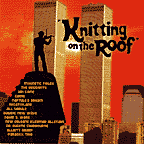 This morning there was a lovely interview with the original songwriting team, on NPR. Listening to Zero sing, and listening to them explain how the play came to be put together reminded me of the recent JAM recording, "Knitting on the Roof." (KFW-260) In this case, some of our favorite edge bands, ranging from the raucous New Orleans Klezmer AllStars to the Residents and Elliott Sharp and Naftule's Dream and the Paradox Trio and Hasidic New Wave and Uri Caine with Lorin Sklamberg (Klezmatics) take on what has become an American Jewish myth.
This morning there was a lovely interview with the original songwriting team, on NPR. Listening to Zero sing, and listening to them explain how the play came to be put together reminded me of the recent JAM recording, "Knitting on the Roof." (KFW-260) In this case, some of our favorite edge bands, ranging from the raucous New Orleans Klezmer AllStars to the Residents and Elliott Sharp and Naftule's Dream and the Paradox Trio and Hasidic New Wave and Uri Caine with Lorin Sklamberg (Klezmatics) take on what has become an American Jewish myth.
Because, as brilliant as the original play was, it has also come to symbolize a flatulence, a faux culture, a Broadway play replacing a way of life that was, at the time, terrifying and horrible and the antithesis of something about which one would want to write a Broadway musical. In thinking of what "Fiddler on the Roof" has come to symbolize in American society 35 years after the original wonder and spark, one is reminded of a line used by the "first" klezmer revival band, The Klezmorim, in their live shows. In describing the American recording industry, and the popularity of Jewish recordings, Lev Liberman or David Julian Gray would say something like, "so, what do you record to attract people who have just escaped the squalor and horror of Eastern Europe? Nostalgia!"
And for its sins--because the original play so perfectly captured the imagination of the world, and then refused to go away until what remained in our consciousness were thousands of horrid covers and trivializations--because the original play came to stand in for everything our grandparents or greatgrandparents lived, whether or not they lived in the shtetls or lived traditional Eastern European lives, it is absolutely and essentially time to move this to the edge, again. And while I wish I could say that this recording, listened to 35 years after the fact, is unlikely to still reach as deeply as Zero Mostel's original recordings do (as if much of anything holds up as well as Zero Mostel; even when he performs dreck, it is dreck filtered through the brilliance of Zero Mostel), it is likely to still be worth many listens now.
Naftule's Dream dissecting "To Life," following the magic of Lorin Sklamberg's voice and Uri Caine's piano on "Sabbath Prayer," for instance, or worth the price of admission alone. Similarly, choosing the New Orleans Klezmer AllStars for "Tradition" was genius.
Anyway, were I not several papers behind, and the end of the semester immanent, there are a slew of recent recordings that I would bring to mind--soon, I hope, if not sooner. But not even I can resist the temptation of reminding people about a very fun recording. If you have Mostel, this is a necessary accompaniment. And, of course, if you have this recording and lack the original Broadway recording, having that, too, that would be a miracle, too.

